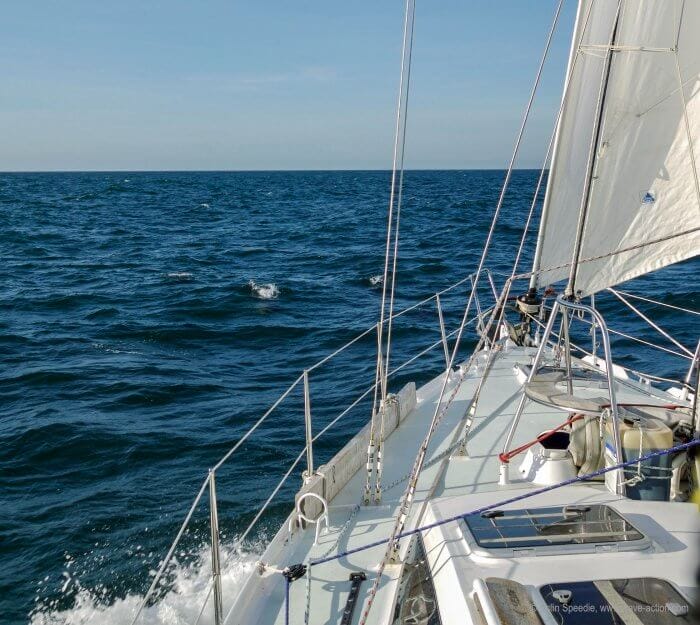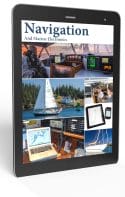
[In Part 1 and Part 2, Colin shared how he plans for a complex coastal passage. Now he puts all of that into practice.]
The weather has been fair for a few days with light to moderate westerly winds and the forecast for the next 48 hours is for similarly settled weather with a change at the end of the period as a shallow Atlantic depression approaches from the west—typical spring weather for this area.
We are just coming off a neap tide and need to be in Oban in around a week’s time, so will be approaching springs at the other end. The boat is ready to go, full of fuel, water and food.
Monday 29thApril in the afternoon we’ll leave Falmouth and be off on a short hop to anchor in Church Cove, on the eastern side of the Lizard peninsula, ready for an early start the following day on the first real leg of this challenging passage that I will detail in the next three parts.


To the uninitiated (I sail the tideless Great Lakes), this seems crazy complicated. Thanks for breaking down your thought process. I hope to one day explore the coasts of Nova Scotia and Newfoundland and this is exactly the type of planning needed for that area.
Hi Colin
Make the most of your last days of freedom to pick your ports and route as you meander up the Irish Sea. If Brexit goes ahead with no deal on 31 October, as seems likely, you will thereafter have to go directly to an Irish port of first entry like the rest of us foreigners, with no anchoring to wait on tide or diverting to a secondary port if the weather looks dodgy. And you will have to clear out of the UK and back in – a tedious affair that took me most of a day last time I did it, as did clearing in to Ireland.
Hi Trevor
good point – quite glad our boat is in Nova Scotia currently! Of course I sailed around here years ago when the regime you describe was still in place – it won’t be any pleasure to go back to it.
Best wishes
Colin
Hi Ben
With our weather and tides it’s always complicated! But that’s what makes it such a good training ground in so many ways. Newfoundland and Nova Scotia are both wonderful, and definitely the sort of places that need good passage planning, so we found our ‘training’ very useful.
Best wishes
Colin
Well done Colin, having sailed everywhere in this commentary on both sides of the Atlantic I’m looking forward to comparing our log with yours when we get back on Maggie, currently near Pisa. Great information. Thank you
Hi James
hope these article (and the next) bring back good memories!
Best wishes
Colin
Hi Colin,
In this article you’re heading out into a part of the world renown for rapid changes in weather and sea state. So a question, when if ever, do you consider turning back if things aren’t as good as forecast? Especially if say a tidal gate is rapidly closing behind you, do you “retire early” or press on trusting on your boat and crew? In passages like this one, there isn’t always a nice easy “plan B”.
We have these kind of decisions in the SW Pacific when leaving say, Fiji. The weather can forecast cracking trade wind conditions, but a high over the sub-tropics causes a squeeze over the Islands with 25-35 knots trade winds and possible 1-3 knot currents and counter eddies, up to 30 nm sail from shore. Turning back is often when boats get broken. Waiting can mean a two week stop for a suitable weather window. I imagine this can be exactly your case in spring / autumn deliveries.
br. Rob
Hi Rob
very good question. I’m generally a ‘turn back early’ guy. If it’s clear when I arrive at a given point that conditions are far worse than expected and are unlikely to improve, I’ll turn back and wait for a better moment. Having said that, because (a) I plan very carefully, including watching the weather evolve and (b) weather forecasting is so much better these days, there are far fewer surprises than there used to be.
And spring/autumn deliveries were always a challenge. As you say, very rapid weather changes can occur. I have sat for a week in Falmouth waiting for persistent strong northerlies to ease, for example, and in Largs for the same length of time waiting for gale force southerlies to abate. There’s really no point in going out and bashing the boat and crew up in such conditions. Do I miss those deliveries? Not much. But there were other times when all went well. It’s a satisfying passage when you get it right.
Best wishes
Colin
Hi Rob et al
The cruising fleet leaving NZ this year for the Sth Pacific certainly faced marginal weather for the trip north. It was a case of looking for very narrow windows and going for it. We were part of the Island Cruising NZ rally who all departed around 28 May based on a window. First night out was dreadful, as forecast, after that settled down and we motored for 36hrs due north to keep above the next approaching low. After that the conditions were tolerable and we had a reasonable passage to Tonga. Boats who were not able to leave NZ at that time had to wait out a procession of lows and even when they did depart had pretty torrid trips. There were boats stuck in Minerva Reef for 7 to 10 days waiting for conditions to abate. We are currently anchored in the Yasawa group (and seems like there is a cell phone tower on every island) and was having a beer with a friend who brought his 110t motorboat (originally a NZ lighthouse tender) up here early this month and said it was the worst trip he had endured to the islands.
The weather forecasts have generally been accurate so we all knew what we were in for.
An important point Colin made is about motoring, on these passages where you are exposed to fast changing conditions you need to keep moving. I carried almost enough fuel to motor between NZ and Tonga and did not hesitate to crank up if speed dropped below 6 kts, total engine hours including battery charging were 87. Will similarly be loaded with fuel for the return trip to NZ from New Caledonia in October.
For those interested you can see the tracks for the ICNZ fleet here, using position reports from Iridium GO
https://forecast.predictwind.com/tracking/rally/ICNZ_2019-PCR/
There are also tracking pages for individual boats which people back home appreciate
Best regards
Alan S/ Comfort Zone
Hi Alan, thanks for the report. Sorry for the delay – just arrived SavuSavu having completed a leg from Tonga to Fiji on a friend’s cat. The rally left later this year, the boats that left in early May had longer weather windows out of NZ. For late starters this year, there wasn’t an easy turn back option, with severe gales coming in close succession over the North Island. In 2017 we learned a valuable lesson as we waited 3 weeks for a succession of cyclones and tropical storms to clear the SW Pacific – the only critical factor (for setting off) is the expected weather on route. Enjoy Vanuatu and New Cal. Rob
Fascinating reading, just the thing to start my education into actual sailing in coastal waters as opposed to always having driven sizable boats with two engines in and around the US San Juan, and Canadian San Juan Islands and Inside Passage, where the main concerns were traffic in the shipping lanes, occasional rough weather, and the tangle of fishing gear in season. I’m sure that soon enough I’ll find myself beating to weather under sail against a tide, but with education and planning I certainly hope to limit that sort of sailing. Then again, there’s probably some value in experiencing those conditions, testing both boat and crew.